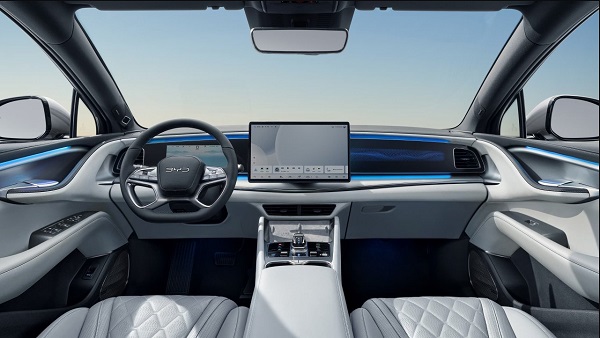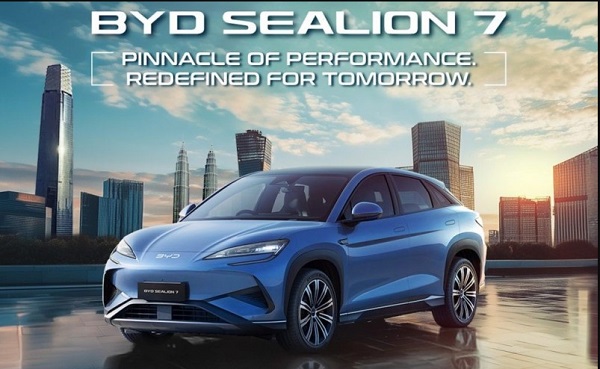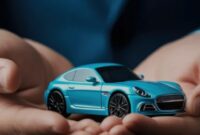The BYD Sealion 07 EV is set to debut in Japan’s passenger car sector this year, marking BYD’s fourth offering in the Japanese market, following the Yuan Plus, Dolphin, and Seal. In 2024, BYD reported sales of 2,223 new energy vehicles (NEVs) in Japan, representing a year-on-year increase of 54 percent.
The Chinese NEV manufacturer presented the Sealion 07 EV at the Tokyo Auto Salon 2025 on January 10, as announced yesterday. The Sealion 07 EV will enter Japan’s passenger vehicle market this year, making it BYD’s fourth model available in the region, alongside the Yuan Plus, Dolphin, and Seal.
Exterior
The Sealion 7 is a four-door SUV characterized by its coupe-inspired roofline, which is currently fashionable. The electric vehicle features BYD’s distinctive front design with sleek LED headlights and daytime running lights (DRLs). Additionally, the vehicle has pronounced wheel arches accented with black cladding. At the rear, the Sealion 7 showcases wraparound LED taillights linked by an LED light strip, a two-tone rear bumper, and a spoiler positioned on the roof.
Interior
Inside the Sealion 7, the design includes a flat-bottom steering wheel and a digital driver’s display measuring 10.25 inches, along with a 15.6-inch rotating touchscreen, similar to its sibling models. The EV is equipped with amenities such as a panoramic sunroof, electrically adjustable front seats featuring heating and ventilation, two-zone automatic climate control, advanced driver assistance systems (ADAS), a 12-speaker audio setup, and a head-up display.
Powertrain
The BYD Sealion 7 is available in both rear-wheel drive (RWD) and all-wheel drive (AWD) layouts, with two battery pack options. The RWD variant with an 82.5kWh battery delivers 308bhp and 380Nm of torque, achieving a range of 482km on a single charge. Conversely, the AWD versions equipped with a 91.3kWh battery produce 523bhp and 690Nm of torque, with driving ranges varying between 456km and 502km depending on the model.
BYD has created an attractive offering with its seventh model for Europe. On paper, the specifications regarding driving performance, battery life, charging capabilities, and pricing suggest a compelling electric vehicle. However, does the Sealion 7 deliver an impressive performance on the road?
Two years post-launch in Europe, BYD now has seven models available: six fully electric and one plug-in hybrid. Nevertheless, the initial six models did not perform as successfully as anticipated, and BYD fell short of its ambitious goals in Europe, despite strong sales figures in China. This was partially attributed to the sales partnerships, which have already undergone significant changes.
Furthermore, the BYD models themselves have not resonated with European consumers. Many buyers are reluctant to invest approximately 70,000 euros in a Han or Tang, given that the brand lacks a rich heritage or established trust. Even the more affordable electric vehicles have not been competitively priced enough to serve as convincing alternatives. Whether marketed as premium or volume vehicles, no BYD model has managed to impress with its fast charging capabilities—unlike Tesla, which has achieved noteworthy charging times of 20 minutes for the Model Y utilizing a BYD blade battery.
This could potentially shift, as BYD seems to have heeded its customers’ feedback: “Numerous customers have requested a powerful SUV that’s also eco-friendly,” stated Ralph Kaiser, the Head of Communications at BYD Europe, during an event in Offenbach near Frankfurt, Germany. Simultaneously, the BYD Sealion 7 is intended to be visually appealing while also ensuring a high level of driving comfort, according to announcements. The marketing team, for now, aims not to target the mass market directly but instead reach those “who seek something extraordinary.” The Sealion 7 is expected not only to meet but to surpass these demands.

BYD with bold claims
But does the vehicle live up to such lofty assertions? The response, following a brief, albeit insufficient, driving experience is both a straightforward yes and no. The journey from Offenbach to the Taunus and back was unfortunately too brief to provide dependable insights into energy consumption and vehicle range. Consequently, we have not yet had the opportunity to evaluate the significantly enhanced fast charging system. While BYD is anticipated to implement further refinements in various aspects, the Sealion 7 already showcases impressive features in other areas.
Before diving into the driving impressions, let’s quickly examine the key details: the Sealion 7 measures 4.83 meters in length (eight centimeters longer than a Model Y), and it comes with either an 82.5 kWh or a 91.3 kWh LFP battery, based on the version, along with an all-wheel drive system that can generate up to 390 kW. An 8-in-1 drive unit, developed in-house, is located at the rear and also integrates the on-board charger.
In the all-wheel drive variants, a simpler 3-in-1 unit is positioned at the front, which consists of an induction motor. The rear axle’s drive unit is a permanently excited synchronous motor that can reach speeds of up to 23,000 revolutions per minute. BYD claims this is the highest figure for a mass-produced electric vehicle, chosen for technical reasons rather than for record-setting purposes. The high-rev design allows BYD to minimize the compromise between dynamics and top speed while eliminating the need for a two-speed transmission.
The rear motor is the same across all three versions and produces 230 kW. This is also the output power of the ‘Comfort’ variant, which comes with the 82.5 kWh battery and rear-wheel drive – in this scenario, it offers a WLTP range of 482 kilometers. In the ‘Design AWD’ version, this battery is paired with an additional electric motor at the front axle. With a combined power of 390 kW, the acceleration time drops from 6.7 to 4.5 seconds (as indicated on the trunk lid under the model designation), although the range also decreases – to 456 kilometers.
When the 390 kW drive is combined with the 91.3 kWh battery, it is designated as ‘Excellence’ and can achieve a WLTP range of 502 kilometers. This premium battery can be charged at a rate of up to 230 kW. Charging from 10 to 80 percent is estimated to take 24 minutes. For the smaller battery, the maximum charge is 150 kW and requires 32 minutes.
BYD (of course) provided the top-level ‘Excellence’ model for the initial test drives. In Sport mode, the vehicle accelerates notably fast – BYD even claims to have surpassed the certified 4.5 seconds in their own testing. We can’t definitively confirm this. However, it’s clear that the accelerator pedal response is not as instantaneous as it is in other electric vehicles, yet the acceleration is comparable in strength. A nice feature is that the response behavior varies significantly with different driving modes. If you prefer a gentler throttle response for everyday driving, you can adjust this using a small rocker switch located in the center console.
The driving modes can be found to the right of the central gear selector, making them somewhat difficult to reach. There is an additional rocker switch on the left side of the selector that allows you to choose between two levels of recuperation. These two options have distinct tuning, but I personally would have preferred more levels – ranging from full coasting to one-pedal driving. Nevertheless, I consider this a personal preference rather than a significant flaw.
Overall, the Sealion 7 makes a strong impression during the initial kilometers. The driving and recuperation systems perform admirably, and the suspension tuning is commendable as well. On the highway, the Sealion 7 maintains a relaxed demeanor, while the interior remains pleasantly quiet at 120 kph, thanks to various insulation methods (BYD claims to have implemented 45 of them). Moreover, the BYD handled corners well as we ascended the Feldberg. While the steering is designed with minimal resistance (common in many Asian vehicles), it still provides enough precision in bends. Given its weight of 2.4 tonnes, we didn’t anticipate a sporty feel from this SUV – the rear-wheel drive version weighs slightly less at 2.2 tonnes, but the difference is not substantial.
We wouldn’t put too much emphasis on the energy consumption figures shown by the onboard computer during the 85-kilometer drive. Depending on the driving conditions, it fluctuated between 19 and 25 kWh/100 kilometers. This suggests a potential range between 365 and 480 kilometers. However, we noticed a drop of 116 kilometers over the course of 85 kilometers in the displayed range (from 465 at 91 percent to 345 at 68 percent). Given that we engage in a variety of activities during such short test drives – from acceleration and cornering to recuperation performance – the consumption data should be seen as a rough estimate rather than a precise measurement: essentially, the Sealion 7 is neither exceptionally fuel-efficient nor overly power-hungry.
One area where BYD could enhance the experience is in the charging software. To start, the filters for locating charging stations in the navigation system are currently quite basic; you can only choose between ‘Any’ and ‘>=50 kW’ for charging speed – filters for ‘150 kW or more’ would be beneficial to make full use of the vehicle’s capabilities. The second filter concerns the types of charging connections. Here, you can filter based on six standards – including those the vehicle cannot utilize with its CCS2 interface. Standards like Type 1, CCS1, or GB/T are irrelevant in Europe. Additionally, it is not possible to filter by operator or charging card.
The software requires further enhancements.
When programming the charging planning, a bit more attention could be beneficial. While the Sealion 7 allows easy addition of charging stations to the route with a single click, the simulated journey from Feldberg to Berlin included only one charging stop for a vehicle that was approximately 85 percent charged. The recommended charging location also seems reasonable, featuring six CCS charging points capable of delivering up to 400 kW. However, details regarding the state of charge upon arrival, the necessary charging time, or the specific charge level needed to reach the final destination are not provided. Additionally, it is unclear what charging services are compatible with the suggested station—there’s no filter available. Inexperienced users who embark on a trip with their new electric vehicle without sufficient background knowledge may find themselves frustrated at the fast charger, which could be alleviated through improved software.
Many reviews of the Sealion 7 mention that the indicator emits a sound reminiscent of a warning notification. The car makes a beeping noise when the indicator is activated, similar to the alert system found in other models, though it is somewhat quieter. However, this is not a significant complaint, as a more traditional clicking sound can also be chosen from the settings menu.
Despite these software issues, the Sealion 7 gave a strong first impression during the initial test drives. The driving comfort is commendable, the seats in both the front and rear are pleasant, and even with the streamlined roofline, there is ample space. The trunk provides a generous capacity of 520 litres, along with an extra sub-trunk; with the rear seats folded down, nearly 1,800 litres can fit into the Sealion 7. All variants also offer a 58-litre frunk under the front hood. The rear-wheel-drive version has a towing capacity of 750 kilograms, while the all-wheel-drive models can handle up to 1,500 kilograms. A roof load of 75 kilograms is also indicated.

Pricing and summary
The Sealion 7 highlights that BYD understands they cannot impose just any price in Europe. The entry-level model is priced at 47,990 euros, the smaller all-wheel-drive variant costs 53,990 euros, and the ‘Excellence’ top-tier variant is priced at 58,990 euros. For commercial leasing over 48 months with a mileage of 10,000 km/year, the Sealion 7 can be leased for 455 euros, while the top version is available for 499 euros. Thus, the Sealion 7 is not inexpensive, but it is also not of inferior quality. In the competitive landscape, these prices—considering the battery capacity—are quite reasonable.
BYD aims to gain favor not only through pricing but also through the quality and design of the vehicle. The initial impression indicates that the level of craftsmanship is quite satisfactory. However, it remains to be seen if customers will concur in the coming year.


